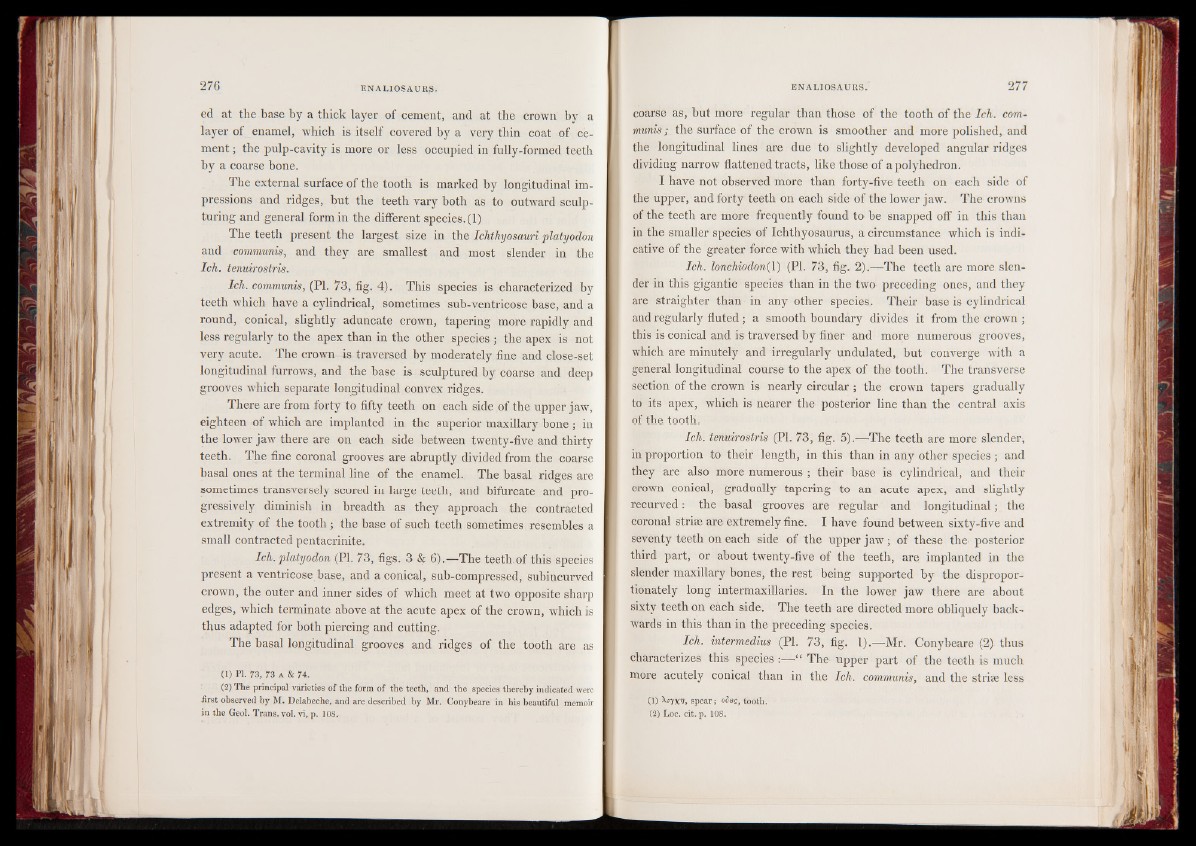
ed at the base by a thick layer of cement, and at the crown by a
layer of enamel, which is itself covered by a very thin coat of cement
; the pulp-cavity is more or less occupied in fully-formed teeth
by a coarse hone.
The external surface of the tooth is marked by longitudinal impressions
and ridges, hut the teeth vary both as to outward sculpturing
and general form in the different species. (1)
The teeth present the largest size in the Ichthyosauri platyodon
and communis, and they are smallest and most slender in the
Ich. tenvirostris.
Ich. communis, (PI. 73, fig. 4). This species is characterized by
teeth which have a cylindrical, sometimes sub-ventricose base, and a
round, conical, slightly aduncate crown, tapering more rapidly and
less regularly to the apex than in the other species ; the apex is not
very acute. The crown is traversed by moderately fine and close-set
longitudinal furrows, and the base is sculptured by coarse and deep
grooves which separate longitudinal convex ridges.
There are from forty to fifty teeth on each side of the upper jaw,
eighteen of which are implanted in the superior maxillary hone ; in
the lower jaw there are on each side between twenty-five and thirty
teeth. The fine coronal grooves are abruptly divided from the coarse
basal ones at the terminal fine of the enamel. The basal ridges are
sometimes transversely scored in large teeth, and bifurcate and progressively
diminish in breadth as they approach the contracted
extremity of the tooth ; the base of such teeth sometimes resembles a
small contracted pentacrinite.
Ich. platyodon (PL 73, figs. 3 & 6).—The teeth, of this species
present a ventricose base, and a conical, sub-compressed, subincurved
crown, the outer and inner sides of which meet at two opposite sharp
edges, which terminate above at the acute apex of the crown, which is
thus adapted for both piercing and cutting.
The basal longitudinal grooves and ridges of the tooth are as
(1) PI. 73, 73 A & 74.
(2) The principal varieties of the form of the teeth, and the species thereby indicated were
first observed by M. Delabeche, and are described by Mr. Conybeare in his beautiful memoir
in the Geol. Trans, vol. vi, p. 108,
coarse as, but more regular than those of the tooth of the Ich. communis;
the surface of the crown is smoother and more polished, and
the longitudinal lines are due to slightly developed angular ridges
dividing narrow flattened tracts, like those of a polyhedron.
I have not observed more than forty-five teeth on each side of
the upper, and forty teeth on each side of the lower jaw. The crowns
of the teeth are more frequently found to be snapped off in this than
in the smaller species of Ichthyosaurus, a circumstance which is indicative
of the greater force with which they had been used.
Ich. lonchiodon{ 1) (PI. 73, fig. 2).'—The teeth are more slender
in this gigantic species than in the two preceding ones, and they
are straighter than in any other species, Their base is cylindrical
and regularly fluted; a smooth boundary divides it from the crown ;
this is conical and is traversed by finer and more numerous grooves,
which are minutely and irregularly undulated, but converge with a
general longitudinal course to the apex of the tooth. The transverse
section of the crown is nearly circular ; the crown tapers gradually
to its apex, which is nearer the posterior line than the central axis
of the tooth.
Ich. tenuirostris (PL 73, fig. 5).—The teeth are more slender,
in proportion to their length, in this than in any other species ; and
they are also more numerous ; their base is cylindrical, and their
crown conical, gradually tapering to an acute apex, and slightly
recurved: the basal grooves are regular and longitudinal; the
coronal striae are extremely fine. I have found between sixty-five and
seventy teeth on each side of the upper jaw; of these the- posterior
third part, or about twenty-five of the teeth, are implanted in the
slender maxillary bones, the rest being supported by the disproportionately
long intermaxillaries. In the lower jaw there are about
sixty teeth on each side. The teeth are directed more obliquely backwards
in this than in the preceding species.
Ich. intermedius (Pl. 73, fig. 1).—Mr. Conybeare (2) thus
characterizes this species “ The upper part of the teeth is much
more acutely conical than in the Ich. communis, and the striae less
(1) ^oyxn, spear; ofoc, tooth.
(2) Loc. cit. p. 108.